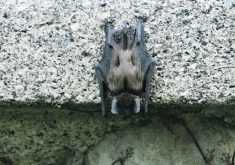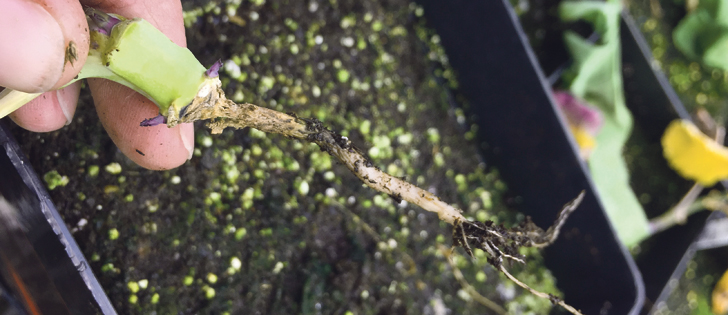A review written 10 years ago by Merle Olson of the University of Calgary’s faculty of biology estimated that 1,415 infectious organisms are known to cause disease in humans and 616 pathogens cause disease in livestock.
One-third of the livestock pathogens are zoonotic, which means they can transmit disease between animals and humans. The diseases are often carried in manure that was spread on fields and then ran into surface or groundwater.
More producers have fenced off dugouts, streams and lakes in recent years to prevent animals from depositing manure and possible pathogens in the water.
Read Also

Farming Smarter receives financial boost from Alberta government for potato research
Farming Smarter near Lethbridge got a boost to its research equipment, thanks to the Alberta government’s increase in funding for research associations.
Instead, water is delivered to them, resulting in healthier animals that are not subjected to water contaminated with feces and urine.
FoodNet Canada, which tracks food-borne illnesses, says it is common to trace enteric human pathogens back to farm animal manure.
For example, campylobacter has been consistently detected in dairy, beef and hog manure but rarely in broiler chicken manure. Salmonella was commonly detected in broiler chicken farms and on hog manure.
Bacteria such as salmonella are harbored by domestic livestock and wildlife and have been known for years to cause serious infection in humans.
Many of these infective agents have survived for thousands of years by constantly evolving and adapting to new conditions.
More recently, newly recognized organisms such as E. coli O157:H7, campylobacter jejuni, listeria monocytogenes and mycobacterium have emerged as important sources of infection in humans.
Other pathogens that are found in manure but restricted to animals can lead to costly illnesses such as scours, bovine viral diarrhea and porcine epidemic diarrhea.
Scours is a well known condition on many farms, especially among young animals.
“Scours is the blanket term we refer to when calves have diarrhea, and that can span anywhere from just having loose stool and still being happy to being flat out and near death,” said Claire Windeyer of the U of C’s faculty of veterinary medicine.
“It embodies that whole spectrum of disease, and it can be caused by a lot of different pathogens. A lot of times you don’t know which pathogen it is. Often it is a combination of pathogens. It is rarely just one,” Windeyer said.
“Management is important to dilute the amount in the environment, trying to avoid the calf’s exposure to it and trying to make sure that calf is as strong and healthy.… It doesn’t really matter which pathogens it meets if you have those other three factors under control.”
Zoonotic bacteria
MYCOBACTERIUM
- Mycobacterium is a group of bacteria associated with tuberculosis.
- Tuberculosis is for the most part a respiratory disease spread through the air, but transmission may occur indirectly from contaminated pastures, water and fomites. Bacteria can also be shed in the milk and feces of animals.
- Mycobacterium bovis has a wide host range, including cattle, humans, pigs and cervids, while mycobacterium paratuberculosis can infect humans, cattle, sheep and goats. It can cause tuberculosis in cattle and humans.
- Mycobacterium paratuberculosis infection in cattle causes paratuberculosis, or Johne’s disease, which is a chronic, incurable condition.
- The bacteria are excreted in milk and feces, and the bacteria spread through the blood to the internal organs. Infected adult animals usually transmit it in their feces to young animals.
- In humans, M. paratuberculosis has been linked to Crohn’s disease, which causes chronic inflammation and thickening of the intestine.
LISTERIA MONOCYTOGENES
- Listeria is a type of bacteria often found in food and elsewhere in nature. It can cause a rare but serious disease called listeriosis.
- Pregnant women, the elderly and individuals with weakened immune systems are at higher risk than others. In serious cases, listeriosis can lead to brain infection and death.
- The Public Health Agency of Canada says it is widespread in the environment, where it is found in soil, vegetation, water, sewage, some types of livestock feed and in the feces of humans and animals. Animals and humans can carry the bacteria without knowing it.
- Plants and vegetables can become contaminated with listeria from soil, water and manure-based fertilizers. Farm animals that appear healthy may also carry listeria and contaminate foods such as meats and dairy products.
- It can survive refrigeration, but it can be killed by pasteurization and proper cooking procedures.
E. COLI
- E. coli is present in the feces of humans, wildlife and domestic livestock. Most strains that are found in the intestines of healthy humans, domestic livestock and wildlife are harmless, and some are a beneficial component of the natural digestion process.
- However there are several harmful strains. The best known is E.coli O157:H7, which is passed by cattle in their manure.
- Its shedding can be affected by the season, age of animal, diet, geographical location, population density and management conditions.
- E. coli O157:H7 is harmless to most animals but can be dangerous to humans if contaminated water or undercooked meat is consumed, especially to those with an immature or weakened immune system.
- Beef can become contaminated by cattle hides and equipment during slaughter and processing and by food handlers in the retail sector.
PARASITES
- A large number of animal parasites can cause infections in humans, but most of them are present in developing countries and in tropical and subtropical areas.
- Giardia duodenalis, cryptosporidium parvum and ascaris suum are the most common parasites of domestic livestock manure.
- Giardia colonizes the small intestine of humans and livestock and can lead to moderate-to-severe diarrhea.
- It is predominantly transmitted through fecal-oral routes, but water-borne and food-borne transmission have been reported. Water contamination with giardia has been associated with agricultural runoff.
- Giardia duodenalis is common in cattle and pigs worldwide. Its prevalence in cattle in Canada is age dependent: 10 percent in adult cattle to 100 percent in calves.
CAMPYLOBACTER
- Campylobacteriosis is one of the most common bacterial causes of diarrheal illness in humans in North America, infecting more than four million people a year.
- There are a number of species of this spiral shaped bacterium.
- Most human outbreaks are associated with the consumption of fecal-contaminated unpasteurized milk and surface water. It may also occur with the mishandling and consumption of fecal-contaminated undercooked poultry or cross-contamination of food by raw poultry.
SALMONELLA
- Salmonella is widespread in the intestines of most wildlife, humans and domestic livestock. It is a leading cause of food poisoning.
- There are many strains of salmonella, and infections can result from direct contact with feces and indirectly from contaminated food and inanimate objects.
- Salmonella bacterial counts start to decrease once on the soil and could reach low levels within 30 days. However, even if manure was spread more than 30 days ago, it is still advisable to thoroughly wash produce, especially below ground varieties that might contain soil or manure.
CRYPTOSPORIDIUM PARVUM
- Cryptosporidium parvum is a small protozoa that colonizes and multiplies in the intestines and sheds its eggs in feces.
- This parasite has been identified in severe intestinal disease in humans and animals over the last 30 years.
- Cryptosporidium can be transmitted by the fecal-oral, water-borne and food-borne routes, but it appears to be more likely associated with water-borne outbreaks.
- Most outbreaks have been traced to human sewage contamination of drinking water, but it has also been associated with livestock manure.
Livestock diseases linked to manure
BOVINE VIRAL DIARRHEA
- Bovine viral diarrhea is an infection that can cause numerous problems in cattle, including damage to the digestive and immune systems and birth defects.
- It can cause high mortality in calves and yearling cattle and has devastating economic consequences to cattle producers.
- It is closely related to the pathogen responsible for hog cholera.
- Infected animals can shed the virus from discharges of the mouth, nose and eyes and in the milk. The highest viral concentrations are found in the manure of infected animals with diarrhea. Many infected bulls also carry the virus in their semen.
- Infection in a pregnant cow may spread to the fetus, which can cause different conditions depending on the age of the fetus.
PORCINE EPIDEMIC DIARRHEA VIRUS
- The porcine epidemic diarrhea virus is primarily spread by fecal-oral contact and can survive in manure for extended periods of time. It is possible for the disease to be spread by any object that becomes contaminated with infected pig manure.
- Recent research at the University of Minnesota shows it can survive in liquid manure for 14 days at room temperature.
- It is most commonly found in manure but can be moved in the wind on dust particles.
- The World Organization for Animal Health says the virus can survive at least 28 days in slurry at 4 C and seven days in feces-contaminated dry feed at 25 C.
Sources: University of Calgary, Public Health Agency of Canada, Washington State College of Veterinary Medicine
Contact barbara.duckworth@producer.com


















